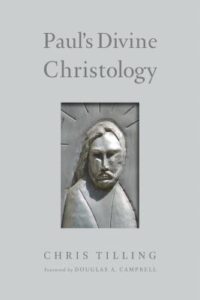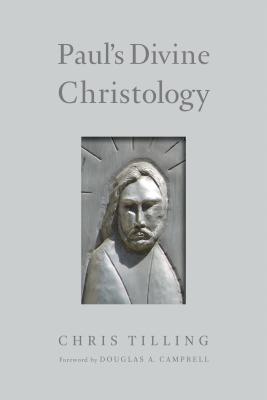Paul’s Divine Christology, by Chris Tilling (Eerdmans, 2015), 346 pp.
 Paul’s Divine Christology is a slightly revised version of Chris Tilling’s Ph.D. dissertation completed in 2009 under Max Turner at the London School of Theology, with Steve Walton and Larry Hurtado as external examiners. It was originally published in 2012 by Mohr Siebeck in the prestigious NT monograph series WUNT II. Tilling’s thesis joins the ranks of Gordon Fee’s Pauline Christology, Larry Hurtado’s Lord Jesus Christ, and Richard Bauckham’s Jesus and the God of Israel as one of the most significant volumes in modern scholarship arguing for (Pauline) divine Christology. That is one reason why this monograph deserves a wide readership and why it is such a good thing that Eerdmans recently released a much more affordable reprint.
Paul’s Divine Christology is a slightly revised version of Chris Tilling’s Ph.D. dissertation completed in 2009 under Max Turner at the London School of Theology, with Steve Walton and Larry Hurtado as external examiners. It was originally published in 2012 by Mohr Siebeck in the prestigious NT monograph series WUNT II. Tilling’s thesis joins the ranks of Gordon Fee’s Pauline Christology, Larry Hurtado’s Lord Jesus Christ, and Richard Bauckham’s Jesus and the God of Israel as one of the most significant volumes in modern scholarship arguing for (Pauline) divine Christology. That is one reason why this monograph deserves a wide readership and why it is such a good thing that Eerdmans recently released a much more affordable reprint.
The other reason why I’m so happy about this reprint is that Paul’s Divine Christology is one of those monographs that should be widely read by non-academics. The subject matter treated here is not something so esoteric that it is meaningless outside the ivory towers of academia. As Tilling notes in the preface to this new edition, “to attend to the dynamics of Paul’s own Christological rhetoric is ultimately to find ourselves wrestling with the challenge of living in communal relationship with the risen Christ today (xx, italics original).
In Paul’s Divine Christology, Tilling builds upon the work of Fee, Hurtado, and Bauckham while avoiding their weaknesses and advances a thesis for Pauline divine Christology that not only strengthens their arguments but also advances the divinity debate with a fresh perspective.
In a nutshell, it will be argued that the whole Pauline divine-Christology debate has yet to grasp sufficiently the most obvious, namely, Paul’s own language and the most appropriate patter of Pauline themes relevant to this debate. By analysing the data in Paul which concerns the relation between the risen Lord and believers, it will be maintained that relational data concerning Christ in Paul’s letters corresponds, as a pattern, only to the language concerning YHWH in second Temple Judaism. It is concluded that the Christ-relation is Paul’s divine-Christology expressed as relationship (3).
Tilling begins with a history of research on Pauline divine Christology that in and of itself provides great value since a detailed history-of-research on this specific topic had not previously been written. Next, Tilling devotes a chapter to showing the need for his study by pointing out the main weaknesses in the works of Fee, Hurtado, and Bauckham on this topic. His critiques here are quite detailed and address a variety of areas, but the key arguments noted from opponents of Pauline divine Christology relate to Hurtado’s emphasis on discontinuity (we have evidence of veneration of intermediary figures in Second Temple literature, which means that veneration of Jesus would not automatically mean He was fully divine alongside the God of Israel) and Bauckham’s case resting on Jews reserving certain predications for God alone (whereas, again, occasional instances can be found where some of these predications are used of intermediary figures). Hence, both Bauckham and Hurtado’s main cases for a fully divine Christology suffer from the presence of (albeit, rare) counterevidence.
Tilling’s approach avoids this fundamental weakness by beginning with Paul rather than Second Temple literature. The bulk of his thesis is advanced through four exegetical chapters that cover the entire undisputed Pauline corpus. Whereas previous studies on Pauline Christology proceed by examining a few texts deemed to be “key,” Tilling avoids the typical narrowness in relation to Paul and shows that according to his scheme, Paul’s divine Christology is everywhere. What’s Tilling’s scheme? It’s a relational one, in which Christ and his people are described in ways that Jews only used to describe the relationship between YHWH and his people.
…this pattern of Christ-relation language in Paul is only that which a Jew used to express the relation between Israel/the individual Jew and YHWH. No other figure of any kind, apart from YHWH, was related to in the same way, with the same pattern of language, not even the various exalted human and angelic intermediary figures in the literature of Second Temple Judaism that occasionally receive worship and are described in very exalted terms (73).
Whereas studies on this topic typically begin with Second Temple literature and end with less attention on Paul, Tilling did just the opposite by first firmly establishing the key contours of Paul’s thought on Jesus through five chapters of robust exegetical work before spending a chapter on Jewish devotion to exalted intermediary figures of the Second Temple period. Whereas these are the counterexamples typically leveraged against Hurtado and Bauckham and perhaps seen as the Achilles’ Heel of the case for a Pauline divine Christology, Tilling demonstrates that there is no parallel with intermediary figures of the God-relation pattern seen in Pauline Christ-relation. In the final main chapter (10) of the book Tilling draws together four points that lead to the conclusion that Paul’s Christ-relation means the affirmation of a divine Christology. Then he briefly revisits nine main arguments used to deny a Pauline divine Christology.
I conclude by reiterating a statement I made at the beginning of this post: Tilling’s thesis joins the ranks of Fee’s Pauline Christology, Hurtado’s Lord Jesus Christ, and Bauckham’s Jesus and the God of Israel as one of the most significant volumes in modern scholarship arguing for (Pauline) divine Christology. Tilling builds on these significant works and leverages the best of their methods and conclusions while avoiding their weaknesses and offering a fresh approach that finally moves the divine Christology debate past its stalemate. This book is a must-read for those interested in the topic of (Pauline) divine Christology, but is also essential reading for those interested in Pauline studies and Christology in general.
This book is a must-read for those interested in the topic of (Pauline) divine Christology Click To TweetPreview it or buy it here on Amazon.


2 comments